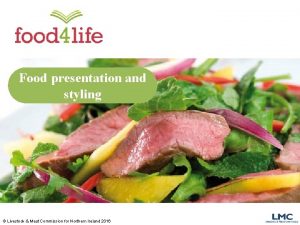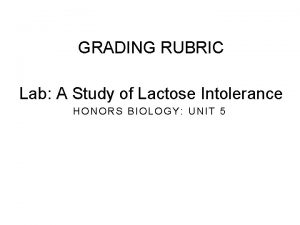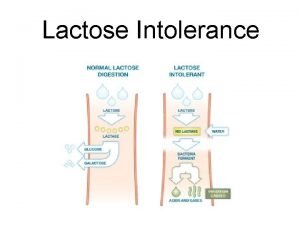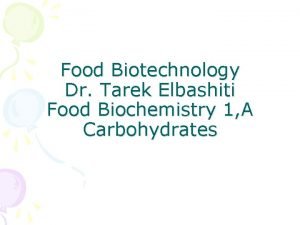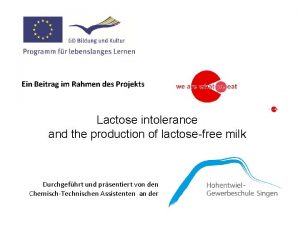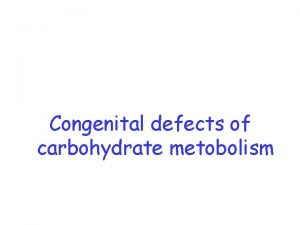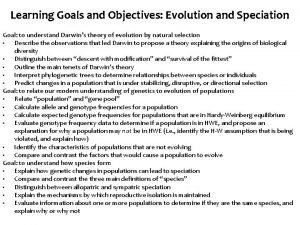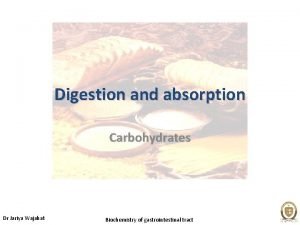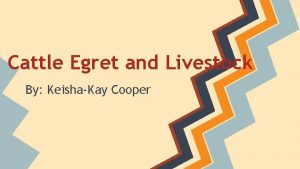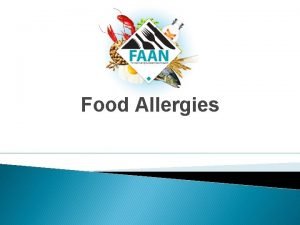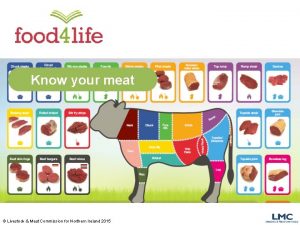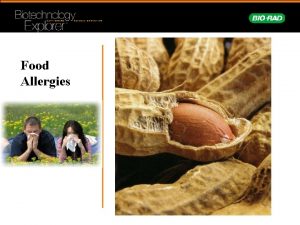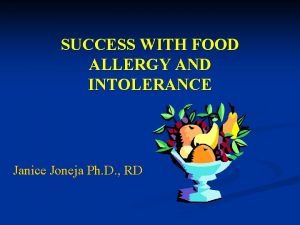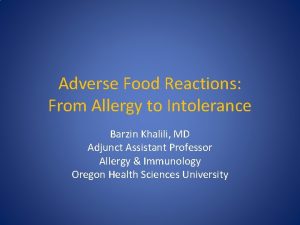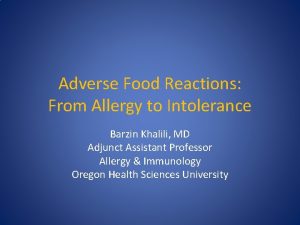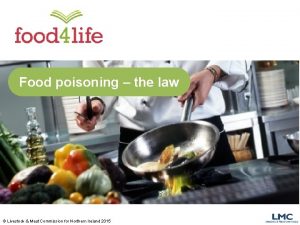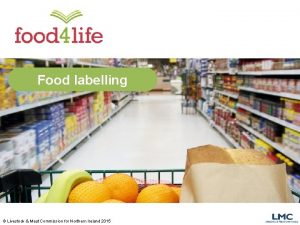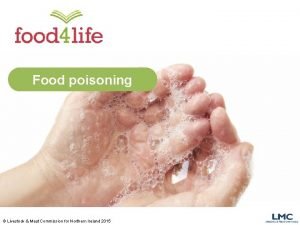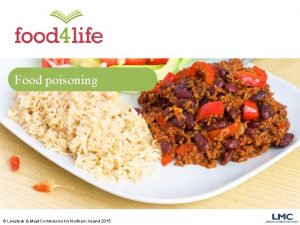Food intolerance and allergy Livestock Meat Commission for

















- Slides: 17

Food intolerance and allergy © Livestock & Meat Commission for Northern Ireland 2015

Learning outcomes Content: Food intolerance and food allergy Students should be able to: • suggest and justify diet and lifestyle advice for individuals with special diets; © Livestock & Meat Commission for Northern Ireland 2015

Food intolerance and allergy Food intolerance is the general term used to describe a range of adverse responses to food including allergic reactions (e. g. peanut allergy, coeliac disease), adverse reactions (e. g. those resulting from enzyme deficiencies such as lactose intolerance). Food allergy can be described as an inappropriate reaction by the body's immune system to the ingestion of a food. Any food has the potential to cause an adverse reaction. Foods that commonly induce adverse reactions include milk, gluten containing cereals, nuts, peanuts, eggs and shellfish. © Livestock & Meat Commission for Northern Ireland 2015

Coeliac disease, an autoimmune disease, is the main form of wheat intolerance, caused by an immune system reaction to gluten. It is also triggered by related proteins in other grains (rye and barley). Coeliac disease is common and affects one in 100 people. However only 24% who have the condition have been diagnosed which means there are currently nearly half a million people who have coeliac disease but don’t yet know (Coeliac UK). © Livestock & Meat Commission for Northern Ireland 2015

Coeliac disease Symptoms range from mild to severe, and can include bloating, diarrhoea, nausea, wind, constipation, tiredness, mouth ulcers, sudden or unexpected weight loss (but not in all cases), hair loss and anaemia. Once diagnosed, the only treatment for coeliac disease is a strict gluten-free diet. Gluten is found in wheat, barley and rye. Some people are also sensitive to oats. People with coeliac disease may have an increased need for calcium compared to the general adult population. (Coeliac UK) © Livestock & Meat Commission for Northern Ireland 2015

Coeliac disease What foods do people with coeliac disease have to avoid? The most obvious sources of gluten in most people’s diet are: bread, pasta, breakfast cereals, flour, pastry, pizza bases, cakes and biscuits. Many gluten free substitutes of these foods now exist. Gluten can also be found in processed foods such as: soups, sauces, ready meals and sausages. © Livestock & Meat Commission for Northern Ireland 2015

Coeliac disease Grains which contain gluten include barley; bulgar wheat, cous, pearl barley, rye, semolina, spelt and wheat. Some people with coeliac disease are also sensitive to oats. (Coeliac UK) © Livestock & Meat Commission for Northern Ireland 2015

Coeliac disease What foods from the bread, rice, potatoes pasta and other starchy food groups can people with coeliac disease eat? Gluten-free bread, cereals, pasta and noodles All plain potatoes (baked, boiled or mashed). Need to check the label of chips, instant mash, potato waffles etc. Rice, quinoa, buckwheat, corn (maize), millet, polenta, soya, tapioca, teff. If agreed with their dietitian, people with coeliac disease can introduce gluten-free oats into their diet. © Livestock & Meat Commission for Northern Ireland 2015

Lactose intolerance The body digests lactose (milk sugar) using an enzyme called lactase to break down lactose into two sugars, glucose and galactose, which can then be easily absorbed into the bloodstream. Lactose intolerance is where someone does not produce enough lactase, so lactose stays in the digestive system where it is fermented by bacteria. This causes the production of various gases, leading to the symptoms associated with lactose intolerance (e. g. flatulence, bloating and distension pain). © Livestock & Meat Commission for Northern Ireland 2015

Lactose intolerance The prevalence of high lactase activity levels in adulthood is most common among people of Northern European countries, where milk and dairy products have been part of the adult daily diet for centuries. In the UK, Sweden, Holland, Belgium and Ireland, only 5% of the population are thought to suffer any degree of lactose intolerance. In the rest of the World, especially among Black and Asiatic communities where milk is not traditionally consumed as part of the typical adult diet, lactase deficiency (low levels of the enzyme) can be almost 100%. © Livestock & Meat Commission for Northern Ireland 2015

Lactose intolerance Complete avoidance of dairy products for people diagnosed with lactose intolerance is not always necessary. With careful experimenting, it is possible to find out the amount of lactose that can be tolerated without adverse symptoms. In the case of mild intolerance, moderating milk intake, taking milk with meals and, where possible, replacing fresh dairy products with fermented dairy products might be enough to keep the intolerance symptoms under control. © Livestock & Meat Commission for Northern Ireland 2015

Lactose intolerance Hard cheeses (e. g. cheddar, Edam) contain very little or no lactose at all. So hard cheeses can often be included in the diet to provide calcium. Lactose-reduced milks available in supermarkets can be used in place of standard milk. Live yogurts are usually better tolerated than fresh milk products. © Livestock & Meat Commission for Northern Ireland 2015

Lactose intolerance People who are very sensitive to lactose should be aware that lactose is widely used as an ingredient in many processed foods. People with lactose intolerance should check the food labels for ingredients and look for other milkderived ingredients that might contain lactose (e. g. whey powder and dried skimmed milk). © Livestock & Meat Commission for Northern Ireland 2015

Lactose intolerance Milk and milk products are important sources of many essential nutrients, e. g. protein, calcium and riboflavin, so avoidance of dairy products is not advised without good reason. If avoidance of milk and milk products is decided, appropriate changes to the diet may need to be made to ensure that nutrient deficiencies do not occur. For example, if alternative sources of calcium are not consumed, intake may be sufficiently low to compromise bone health. © Livestock & Meat Commission for Northern Ireland 2015

Lactose intolerance What are some alternative sources of calcium for people who decide to avoid milk and milk products? Some green leafy vegetables, e. g. broccoli. Canned fish (if containing bones that are soft and can be consumed). Fortified soya products. Bread. © Livestock & Meat Commission for Northern Ireland 2015

Peanut allergy Peanuts, also called ground nuts or monkey nuts, are a common cause of food allergies especially in the USA where the consumption of peanuts is high. Symptoms of peanut allergy tend to appear almost immediately after exposure in sensitised people. Peanut allergy can be very severe and in some cases life threatening. Foods which may contain peanuts include: blended oils, unrefined/gourmet peanut oils, groundnut oils, biscuits, peanut butter, some cakes and certain dishes e. g. satay sauce. (Allergy UK). It is important to always check the label! © Livestock & Meat Commission for Northern Ireland 2015

Acknowledgement For further information, go to: www. food 4 life. org. uk © LMC 2015 © Livestock & Meat Commission for Northern Ireland 2015
 Livestock meat commission
Livestock meat commission Food allergy testing auckland
Food allergy testing auckland Market forms of imported meat
Market forms of imported meat Lactose test strips
Lactose test strips Graduated commission formula
Graduated commission formula Intolerance in the crucible act 1
Intolerance in the crucible act 1 Stibio intolérance definition
Stibio intolérance definition Lactose
Lactose Lactose intolerance by country
Lactose intolerance by country John proctor quotes in the crucible
John proctor quotes in the crucible Maltose intolerance
Maltose intolerance Lactose intolerance map
Lactose intolerance map Fructose intolerance enzyme
Fructose intolerance enzyme Lactose intolerance histology
Lactose intolerance histology Lactose intolerance gene
Lactose intolerance gene Digestion and absorption of carbohydrates biochemistry
Digestion and absorption of carbohydrates biochemistry Aim of mudaliar commission
Aim of mudaliar commission Cattle egret and cattle symbiotic relationship
Cattle egret and cattle symbiotic relationship
